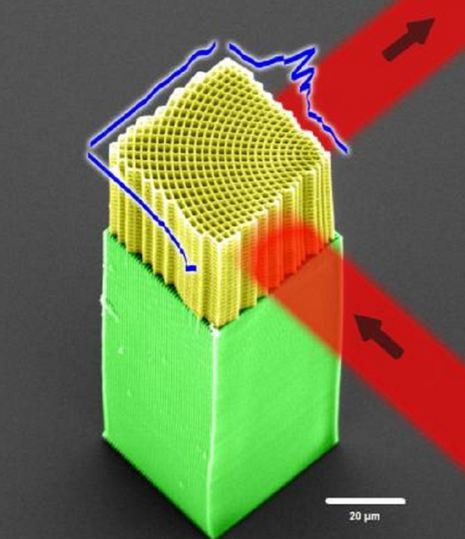MIniature Light Bending Device Opens Door to Ultra-Fast Supercomputers
| Arthur Dominic Villasanta | | Mar 20, 2015 11:13 AM EDT |
(Photo : University of Central Florida) The honeycomb-like lattice that bends light.
Scientists in the United States have found a more effective way to transmit data rapidly on electronic circuit boards by bending light at more extreme angles.
It's a groundbreaking technology that will lead to the next generation of ultra-fast supercomputers.
The device that makes this possible resembles a tiny plastic honeycomb infinitely smaller than a bee's stinger. It can steer light beams around tighter curves than ever before while keeping the integrity and intensity of the beam intact.
Like Us on Facebook
The success was achieved by researchers at the University of Texas El Paso (UTEP) and at the University of Central Florida (UCF),
The study reporting this breakthrough noted that sending information on light beams instead of electrical signals allows data to be transmitted thousands of times faster. There's a significant drawback to using light, however, and that's controlling the light beams without losing their energy.
"Computer chips and circuit boards have metal wire connections within them that transport data signals," said Raymond Rumpf, professor of electrical and computer engineering at UTEP.
"One of challenges when using light is figuring out a way to make tight bends so we can replace the metal wiring more effectively."
Stephen Kuebler, an associate professor of chemistry at UCF, said direct laser writing has the potential to become a flexible means for manufacturing next-generation computer devices.
Kuebler and his students used direct laser writing, which is a kind of nanoscale 3D printing, to create the miniature lattices. The team then ran light beams through the lattices and confirmed they could flow light without loss through turns twice as tight as any done previously.
The finding is significant because with the demand for ever-smaller and faster computers and hand-held devices, engineers need ways to pack ultra-fast data-transmission devices into smaller spaces.
Microchip and computer manufacturers are looking to light as the best way to overcome speed limitations imposed by today's electronics.
Conventional light waveguides like optical fibers can be used to steer light through turns but the turns must be gradual. If the turn is too quick, the light beams escape and energy is lost.
To make ultra-sharp turns, the team designed the plastic devices so its lattice steers the beam around corners without losing energy.
The UTEP-UCF team's technology creates a new record in the field of optics for its ability to bend light beams.
Kuebler said the team is now working to double that record, creating a lattice that will turn the light through an even tighter turn.
Rumpf envisions this groundbreaking technology will first appear in high-performance super computers before it can be found in people's everyday laptops.
©2015 Chinatopix All rights reserved. Do not reproduce without permission
EDITOR'S PICKS
-

Did the Trump administration just announce plans for a trade war with ‘hostile’ China and Russia?
-

US Senate passes Taiwan travel bill slammed by China
-

As Yan Sihong’s family grieves, here are other Chinese students who went missing abroad. Some have never been found
-

Beijing blasts Western critics who ‘smear China’ with the term sharp power
-

China Envoy Seeks to Defuse Tensions With U.S. as a Trade War Brews
-

Singapore's Deputy PM Provides Bitcoin Vote of Confidence Amid China's Blanket Bans
-

China warns investors over risks in overseas virtual currency trading
-

Chinese government most trustworthy: survey
-

Kashima Antlers On Course For Back-To-Back Titles
MOST POPULAR
LATEST NEWS
Zhou Yongkang: China's Former Security Chief Sentenced to Life in Prison

China's former Chief of the Ministry of Public Security, Zhou Yongkang, has been given a life sentence after he was found guilty of abusing his office, bribery and deliberately ... Full Article
TRENDING STORY

China Pork Prices Expected to Stabilize As The Supplies Recover

Elephone P9000 Smartphone is now on Sale on Amazon India

There's a Big Chance Cliffhangers Won't Still Be Resolved When Grey's Anatomy Season 13 Returns

Supreme Court Ruled on Samsung vs Apple Dispute for Patent Infringement

Microsoft Surface Pro 5 Rumors and Release Date: What is the Latest?










